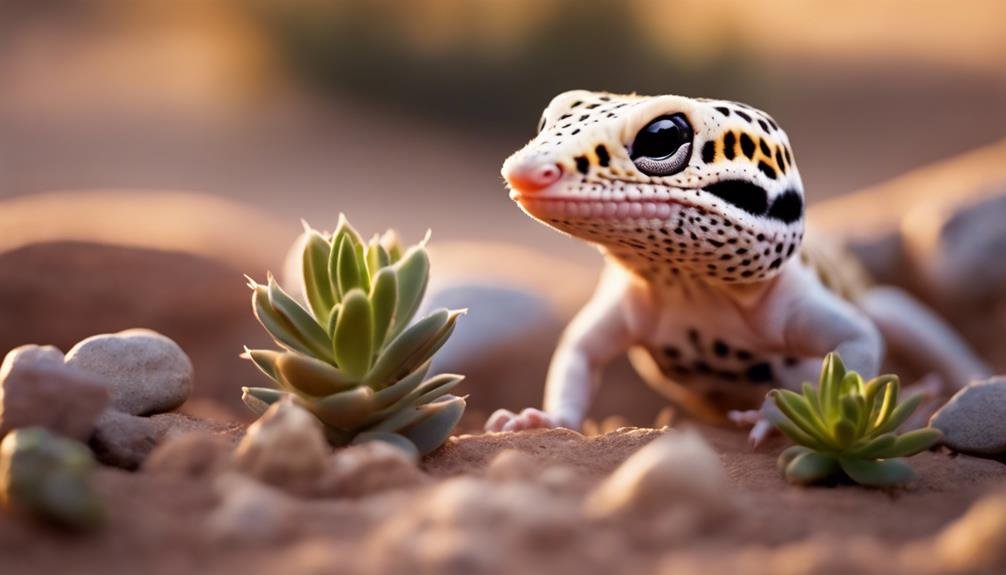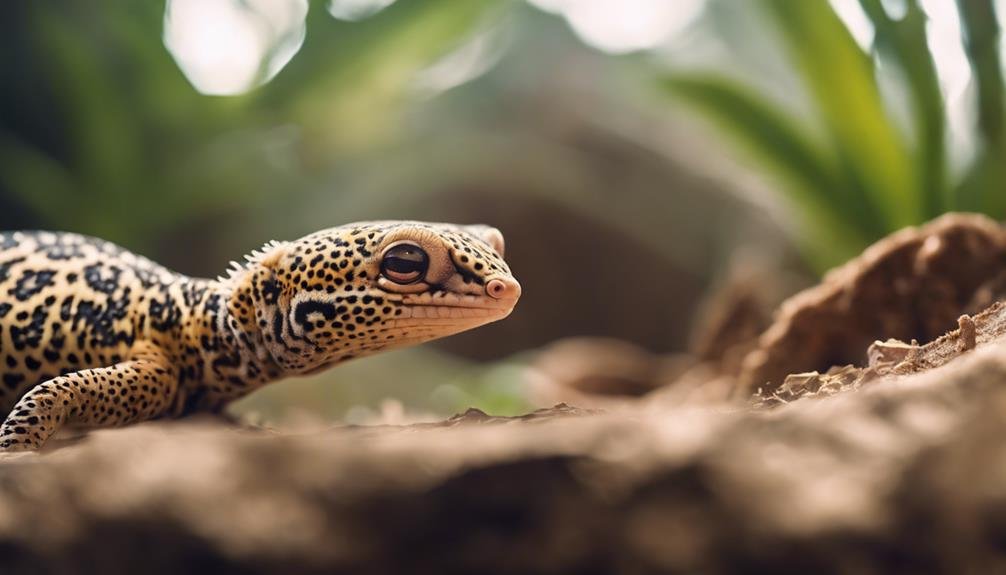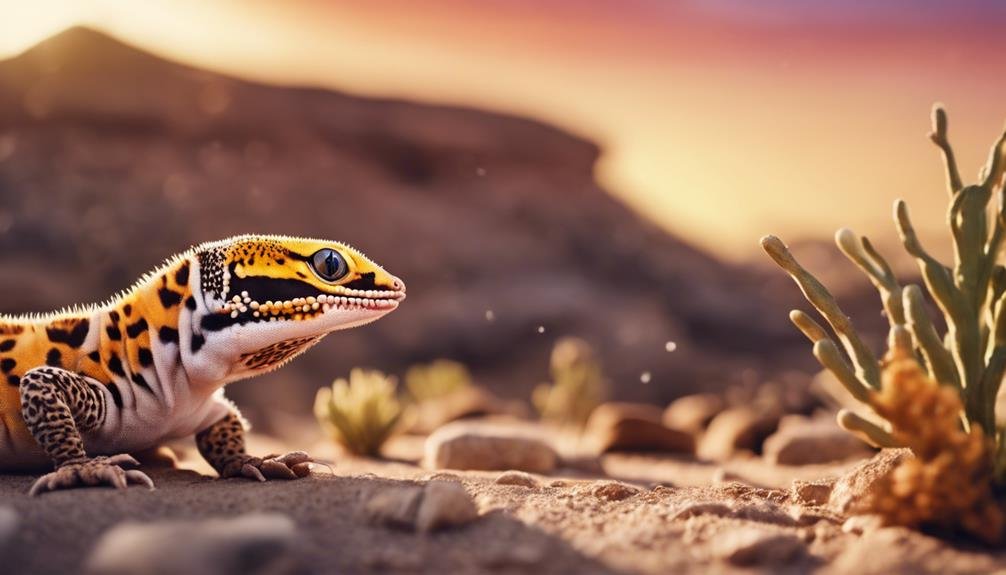You might think you know leopard geckos from their popularity in the pet trade, but their origins in the rocky, arid landscapes of South Asia offer a stark contrast to the terrariums they often inhabit now. These resilient creatures have adapted to some of the most unforgiving environments, relying on their unique behaviors and physical adaptations to survive. As you explore their natural habitat, you'll uncover how these environments have shaped their diet, behavior, and even their physical appearance. This journey into the native lands of leopard geckos will surely leave you wondering how such a delicate balance of life persists in these harsh conditions.
Key Takeaways
- Leopard geckos are native to rocky, dry grasslands and desert regions in South Asia.
- Their habitats are characterized by arid conditions, sparse vegetation, and rocky terrains.
- They utilize burrows and shaded areas within their environment to regulate body temperature.
- The geckos' natural habitat includes sandy or clay soils, ideal for burrowing and seeking shelter.
- They thrive in environments that allow for nocturnal hunting, using their camouflage to blend into the arid forests and rocky habitats.
Native Regions and Geography
Leopard geckos call the rocky, dry grasslands and desert areas of South Asia, including Pakistan, India, and Afghanistan, their home. These habitats are characterized by their arid nature, featuring sparse vegetation and a landscape dominated by rocky terrains and compacted sand. Unlike other regions that boast lush forests and abundant water sources, the areas where leopard geckos thrive are much harsher, requiring unique adaptations for survival.
In these desert regions, leopard geckos have mastered the art of thermoregulation. They utilize burrows and shaded spots as retreats from the extreme heat during the day, emerging at night when temperatures are more favorable. This behavior not only helps them maintain an ideal body temperature but also aids in their survival against predators. The ability to blend into the arid forests and rocky habitats, thanks to their distinctive, camouflage-friendly skin patterns, further enhances their chances of survival.
Leopard geckos' selection of habitat in South Asia, avoiding areas with primary sand substrate, underscores their preference for environments where they can easily create burrows. These burrows serve multiple purposes, from offering protection from the elements and predators to acting as a safe spot for laying eggs. Their adaptation to these specific environmental conditions showcases their remarkable resilience and the critical importance of their native habitat's geography to their survival.
Habitat and Environmental Conditions
In the rocky deserts of South Asia, including countries like Pakistan, India, and Afghanistan, leopard geckos have adapted to thrive in conditions that are both arid and sparse in vegetation. Their natural habitat is characterized by rocky terrains and sandy or clay soils, which perfectly suits their needs for burrowing and seeking shelter.
These resilient creatures have evolved to withstand the challenges posed by arid environments, relying on their ability to maneuver through the rocky substrates to their advantage for hiding from predators and hunting for food. Despite the sparse vegetation in their surroundings, they've mastered the art of finding sustenance and shelter, often seeking refuge under loose bark or within the crevices of rocks.
As the temperatures drop in winter, they enter a state of semi-hibernation, retreating underground to protect themselves from the low winter temperatures. This ability to adapt to both the scorching heat and the cold makes leopard geckos remarkable survivors in their natural habitat, showcasing their resilience in the face of fluctuating environmental conditions.
Diet and Prey Preferences


To guarantee, it's crucial to
Beyond adapting to harsh environments, leopard geckos also have specific dietary habits rooted in their role as opportunistic predators. Their diet is primarily composed of invertebrates such as crickets, roaches, mealworms, and even scorpions. Thanks to their nocturnal nature, these reptiles hunt at night, utilizing the cover of darkness to ambush their prey.
Your leopard gecko's prey preferences aren't just a matter of taste; they're a necessity for survival. In the wild, controlling insect populations is a natural role for them, contributing to the ecological balance. During the summer reproductive season, this dietary habit becomes even more critical. Female leopard geckos require adequate nutrition not only for their well-being but also to ensure successful egg production and reproductive health.
In captivity, it's crucial to mimic this natural diet to keep your leopard gecko healthy. A variety of commercially available insects can provide them with the necessary nutrition. Offering a diet that closely resembles their natural prey preferences helps in maintaining their overall health and well-being, guaranteeing they thrive under your care.
Behavioral Patterns and Adaptations
Adapting to their harsh environments, leopard geckos often showcase unique behavioral patterns and adaptations that aid their survival. These creatures have mastered the art of living under the radar while thriving in conditions that would challenge many. Their nocturnal behavior is a proof of this adaptability, allowing them to be most active during dusk when it's cooler.
- Nocturnal Behavior: They've evolved to become night dwellers, using rocks for heat and remaining secretive during the day. This not only helps them regulate their body temperature but also keeps them safe from predators.
- Defense Mechanism: When danger approaches, leopard geckos may vocalize or, more fascinatingly, detach their tail. This tail, which can twitch as a distraction, allows them a chance to escape, showcasing an incredible adaptation for survival.
- Regenerated Tails: If they lose their tail, it will grow back, though the new one will be shorter and wider. These regenerated tails serve as a form of defense, still capable of twitching to ward off any future threats.
Through these adaptations, leopard geckos navigate their world with a blend of stealth and resilience, thriving in the face of adversity.
Conservation Status and Threats


While leopard geckos have shown remarkable resilience in the wild, it's important to explore their conservation status and the threats they face. Currently, leopard geckos aren't considered threatened or endangered, largely thanks to the stable conditions of their native rocky desert regions. This stable population status is a proof of their adaptability and the relative health of their natural habitat.
However, it's not all smooth sailing. The historical impact of the pet trade, while not notably harmful, has posed potential threats to wild populations. The key to mitigating these risks lies in responsible pet ownership and a strong stance against wild collection. By choosing captive-bred leopard geckos and educating yourself on their care, you're contributing to their ongoing safety and wellbeing.
Moreover, zoos play an important part in this conservation puzzle. Through education and awareness efforts, zoos help the public understand the importance of these creatures and the specific challenges they face. By fostering a deeper appreciation for leopard geckos and their natural environments, zoos contribute significantly to the efforts of keeping wild populations stable and thriving.
Does Eco Earth mimic the natural habitat of Leopard Geckos?
Yes, eco earth leopard geckos substrates are designed to mimic the natural habitat of leopard geckos. This substrate is made from coconut fibers and is great for holding moisture, creating a humid environment similar to the gecko’s natural habitat. It also allows for burrowing and egg-laying.
Frequently Asked Questions
Where Did Leopard Geckos Evolve From?
You're curious about where leopard geckos originally evolved from. Their ancestral lineage, shaped by gecko genetics, traces back to South Asia's rocky, arid landscapes.
Their evolutionary adaptations, influenced by climatic conditions and predation pressures, led to unique survival mechanisms, diet evolution, and morphological changes.
These adaptations, including reproductive strategies, allowed them to thrive across a wide geographic distribution, showcasing their ability to adapt to harsh environments through generations.
Is a Leopard Gecko Tropical or Desert?
You might wonder if a leopard gecko is tropical or desert-based. They're actually desert creatures, adapted to arid conditions with specific needs in temperature regulation and low humidity levels. Their skin shedding, nocturnal activity, and dietary habits are all suited to dry environments.
In captivity, mimic their natural habitat with proper substrate preferences, a terrarium setup that includes UVB lighting, and make sure they've access to water sources for best care.
Where Do Leopard Geckos Hide in the Wild?
In the wild, you'll find leopard geckos tucked away in rock crevices and sandy burrows, utilizing these nocturnal shelters for prey stalking and moisture seeking. They're masters of temperature regulation, choosing underbrush camouflage to stay cool and evade predators.
During daylight, they're hiding experts, using their environment for survival strategies. Whether it's for predator evasion or just surviving, their knack for finding the perfect hideout is unmatched.
Where Do Geckos Originate From?
You're likely curious about where geckos originate from, particularly considering their unique adaptation strategies and geographic distribution patterns. These fascinating creatures, known for their nocturnal activities and diet variations, hail from diverse regions globally.
Their survival is deeply influenced by habitat conservation issues and climate impact studies. Remarkably, their breeding season behaviors, predator avoidance tactics, and skin shedding cycles are all adaptations to their specific environments, highlighting the importance of understanding their natural habitats for effective conservation.
Conclusion
To sum up, you've observed that leopard geckos originate from the arid landscapes of South Asia, where they've skillfully adapted to thrive. Their homes in rocky, dry grasslands provide the perfect backdrop for their survival tactics, from camouflaging to burrowing. They're not just survivors; they're adept hunters, preying on insects that share their habitat.
Yet, despite their resilience, they face threats that challenge their existence. It's essential we comprehend and protect these unique creatures and their natural homes.


